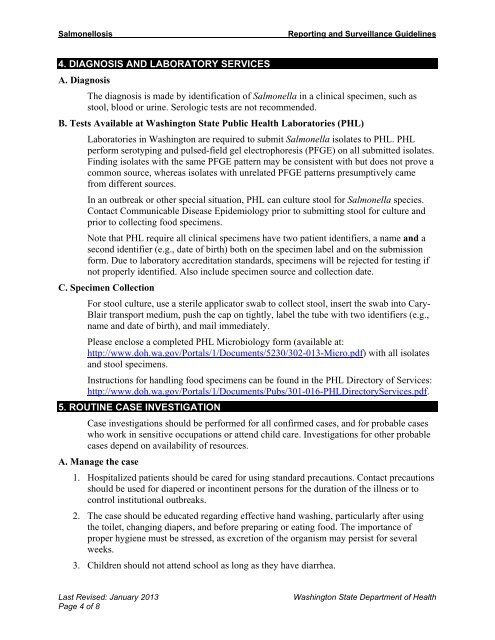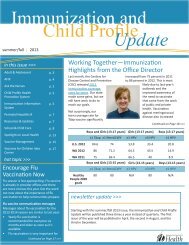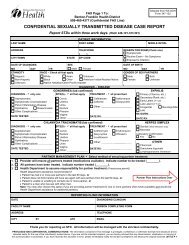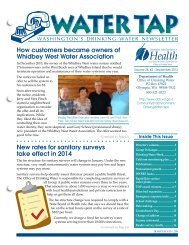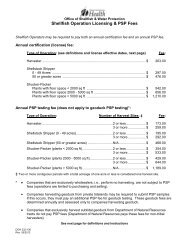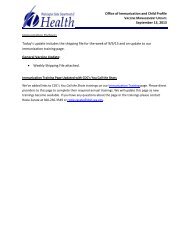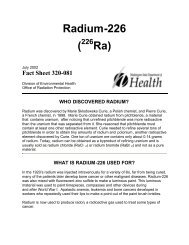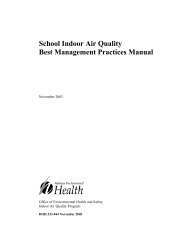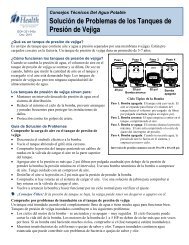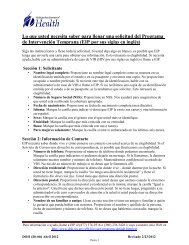Salmonellosis Reporting and Investigation Guideline - Washington ...
Salmonellosis Reporting and Investigation Guideline - Washington ...
Salmonellosis Reporting and Investigation Guideline - Washington ...
Create successful ePaper yourself
Turn your PDF publications into a flip-book with our unique Google optimized e-Paper software.
<strong>Salmonellosis</strong><br />
<strong>Reporting</strong> <strong>and</strong> Surveillance <strong>Guideline</strong>s<br />
4. DIAGNOSIS AND LABORATORY SERVICES<br />
A. Diagnosis<br />
The diagnosis is made by identification of Salmonella in a clinical specimen, such as<br />
stool, blood or urine. Serologic tests are not recommended.<br />
B. Tests Available at <strong>Washington</strong> State Public Health Laboratories (PHL)<br />
Laboratories in <strong>Washington</strong> are required to submit Salmonella isolates to PHL. PHL<br />
perform serotyping <strong>and</strong> pulsed-field gel electrophoresis (PFGE) on all submitted isolates.<br />
Finding isolates with the same PFGE pattern may be consistent with but does not prove a<br />
common source, whereas isolates with unrelated PFGE patterns presumptively came<br />
from different sources.<br />
In an outbreak or other special situation, PHL can culture stool for Salmonella species.<br />
Contact Communicable Disease Epidemiology prior to submitting stool for culture <strong>and</strong><br />
prior to collecting food specimens.<br />
Note that PHL require all clinical specimens have two patient identifiers, a name <strong>and</strong> a<br />
second identifier (e.g., date of birth) both on the specimen label <strong>and</strong> on the submission<br />
form. Due to laboratory accreditation st<strong>and</strong>ards, specimens will be rejected for testing if<br />
not properly identified. Also include specimen source <strong>and</strong> collection date.<br />
C. Specimen Collection<br />
For stool culture, use a sterile applicator swab to collect stool, insert the swab into Cary-<br />
Blair transport medium, push the cap on tightly, label the tube with two identifiers (e.g.,<br />
name <strong>and</strong> date of birth), <strong>and</strong> mail immediately.<br />
Please enclose a completed PHL Microbiology form (available at:<br />
http://www.doh.wa.gov/Portals/1/Documents/5230/302-013-Micro.pdf) with all isolates<br />
<strong>and</strong> stool specimens.<br />
Instructions for h<strong>and</strong>ling food specimens can be found in the PHL Directory of Services:<br />
http://www.doh.wa.gov/Portals/1/Documents/Pubs/301-016-PHLDirectoryServices.pdf.<br />
5. ROUTINE CASE INVESTIGATION<br />
Case investigations should be performed for all confirmed cases, <strong>and</strong> for probable cases<br />
who work in sensitive occupations or attend child care. <strong>Investigation</strong>s for other probable<br />
cases depend on availability of resources.<br />
A. Manage the case<br />
1. Hospitalized patients should be cared for using st<strong>and</strong>ard precautions. Contact precautions<br />
should be used for diapered or incontinent persons for the duration of the illness or to<br />
control institutional outbreaks.<br />
2. The case should be educated regarding effective h<strong>and</strong> washing, particularly after using<br />
the toilet, changing diapers, <strong>and</strong> before preparing or eating food. The importance of<br />
proper hygiene must be stressed, as excretion of the organism may persist for several<br />
weeks.<br />
3. Children should not attend school as long as they have diarrhea.<br />
Last Revised: January 2013<br />
Page 4 of 8<br />
<strong>Washington</strong> State Department of Health


